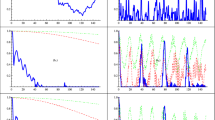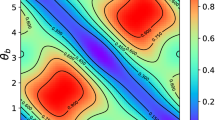Abstract
We consider two qubits prepared in a product state and evolved under the magnetic dipolar interaction (MDI). We describe the dependence of the entanglement generated by the MDI with time, with the interaction parameters, and with the system’s initial state, identifying the symmetry and coherence aspects of those initial configurations that yield the maximal entanglement. We also show how one can obtain maximum entanglement from the MDI applied to some families of partially entangled initial states.




Similar content being viewed by others
Notes
The Gibbs thermal state has the form: \(\rho _{th}=Z^{-1}e^{-\beta H}\), where \(Z=\mathrm {Tr}(e^{-\beta H})\) is the partition function and \(\beta =(k_\mathrm{B}T)^{-1}\), with T being the bath temperature and \(k_\mathrm{B}\) being the Boltzmann constant.
References
Popescu, S., Short, A.J., Winter, A.: Entanglement and the foundations of statistical mechanics. Nat. Phys. 2, 754 (2006)
Neumann, P., Kolesov, R., Naydenov, B., Beck, J., Rempp, F., Steiner, M., Jacques, V., Balasubramanian, G., Markham, M.L., Twitchen, D.J., Pezzagna, S., Meijer, J., Twamley, J., Jelezko, F., Wrachtrup, J.: Quantum register based on coupled electron spins in a room-temperature solid. Nat. Phys. 6, 249 (2010)
Dolde, F., Jakobi, I., Naydenov, B., Zhao, N., Pezzagna, S., Trautmann, C., Meijer, J., Neumann, P., Jelezko, F., Wrachtrup, J.: Room-temperature entanglement between single defect spins in diamond. Nat. Phys. 9, 139 (2013)
Choi, J., Zhou, H., Choi, S., Landig, R., Ho, W.W., Isoya, J., Jelezko, F., Onoda, S., Sumiya, H., Abanin, D.A., Lukin, M.D.: Probing quantum thermalization of a disordered dipolar spin ensemble with discrete time-crystalline order. arXiv:1806.10169 (2018)
Furman, G.B., Meerovich, V.M., Sokolovsky, V.L.: Entanglement in dipolar coupling spin system in equilibrium state. Quantum Inf. Process. 11, 1603 (2012)
Kuznetsova, E.I., Yurischev, M.A.: Quantum discord in spin systems with dipole–dipole interaction. Quantum Inf. Process. 12, 3587 (2013)
Furman, G.B., Goren, S.D., Meerovich, V.M., Sokolovsky, V.L.: Quantum correlations at negative absolute temperatures. Quantum Inf. Process. 13, 2759 (2014)
Castro, C.S., Duarte, O.S., Pires, D.P., Soares-Pinto, D.O., Reis, M.S.: Thermal entanglement and teleportation in a dipolar interacting system. Phys. Lett. A 380, 1571 (2016)
Furman, G.B., Meerovich, V.M., Sokolovsky, V.L.: Multiple quantum NMR and entanglement dynamics in dipolar coupling spin systems. Phys. Rev. A 78, 042301 (2008)
Hu, Z.-D., Wang, J., Zhang, Y., Zhang, Y.-Q.: Sudden transitions of trace distance discord of dipole–dipole coupled two qubits. Int. J. Mod. Phys. B 29, 1550138 (2015)
Khan, S., Jan, M.: The effect of dipole–dipole interaction on tripartite entanglement in different cavities. Int. J. Theor. Phys. 55, 1515 (2016)
Mohamed, A.-B.A.: Geometric measure of nonlocality and quantum discord of two charge qubits with phase decoherence and dipole–dipole interaction. Rep. Math. Phys. 72, 121 (2013)
Namitha, C.V., Satyanarayana, S.V.M.: Role of initial coherence on entanglement dynamics of two qubit X states. J. Phys. B At. Mol. Opt. Phys. 51, 045506 (2018)
Zhou, Y.-L., Ou, B.-Q., Wu, W.: Quantum simulating the frustrated Heisenberg model in a molecular dipolar crystal. Phys. Lett. A 379, 2569 (2015)
Yun, S.J., Kim, J., Nam, C.H.: Ising interaction between two qubits composed of the highest magnetic quantum number states through magnetic dipole–dipole interaction. J. Phys. B At. Mol. Opt. Phys. 48, 075501 (2015)
Nielsen, M.A., Chuang, I.L.: Quantum Computation and Quantum Information. Cambridge University Press, Cambridge (2000)
Maziero, J., Werlang, T., Fanchini, F.F., Céleri, L.C., Serra, R.M.: System-reservoir dynamics of quantum and classical correlations. Phys. Rev. A 81, 022116 (2010)
Pozzobom, M.B., Maziero, J.: Environment-induced quantum coherence spreading of a qubit. Ann. Phys. 377, 243 (2017)
Klauder, J.R., Anderson, P.W.: Spectral diffusion decay in spin resonance experiments. Phys. Rev. 125, 912 (1962)
Soares-Pinto, D.O., Moussa, M.H.Y., Maziero, J., de Azevedo, E.R., Bonagamba, T.J., Serra, R.M., Céleri, L.C.: Equivalence between redfield- and master-equation approaches for a time-dependent quantum system and coherence control. Phys. Rev. A 83, 062336 (2011)
Shiddiq, M., Komijani, D., Duan, Y., Gaita-Arino, A., Coronado, E., Hill, S.: Enhancing coherence in molecular spin qubits via atomic clock transitions. Nature 531, 348 (2016)
Ota, T., Yusa, G., Kumada, N., Miyashita, S., Fujisawa, T., Hirayama, Y.: Decoherence of nuclear spins due to dipole–dipole interactions probed by resistively detected nuclear magnetic resonance. Appl. Phys. Lett. 91, 193101 (2007)
Stamp, P.C.E.: Environmental decoherence versus intrinsic decoherence. Philos. Trans. R. Soc. A Math. Phys. Eng. Sci. 370, 4429 (2012)
Witzel, W.M., Carroll, M.S., Cywi’nski, L., Sarma, S.D.: Quantum decoherence of the central spin in a sparse system of dipolar coupled spins. Phys. Rev. B 86, 035452 (2012)
Annabestani, R., Cory, D.G.: Dipolar relaxation mechanism of long-lived states of methyl groups. Quantum Inf. Process. 17, 15 (2018)
Streltsov, A., Adesso, G., Plenio, M.B.: Quantum coherence as a resource. Rev. Mod. Phys. 89, 041003 (2017)
Streltsov, A., Singh, U., Dhar, H.S., Bera, M.N., Adesso, G.: Measuring quantum coherence with entanglement. Phys. Rev. Lett. 115, 020403 (2015)
Oliveira, I.S., Bonagamba, T.J., Sarthour, R.S., Freitas, J.C.C., deAzevedo, E.R.: NMR Quantum Information Processing. Elsevier, Oxford (2007)
Horodecki, R., Horodecki, P.: Perfect correlations in the Einstein–Podolski–Rosen experiment and Bell’s inequalities. Phys. Lett. A 210, 227 (1996a)
Horodecki, R., Horodecki, M.: Information-theoretic aspects of quantum inseparability of mixed states. Phys. Rev. A 54, 1838 (1996b)
Baumgratz, T., Cramer, M., Plenio, M.B.: Quantifying coherence. Phys. Rev. Lett. 113, 140401 (2014)
Wootters, W.K.: Entanglement of formation of an arbitrary state of two qubits. Phys. Rev. Lett. 80, 2245 (1998)
Bennett, C.H., Brassard, G., Cr’epeau, C., Jozsa, R., Peres, A., Wootters, W.K.: Teleporting an unknown quantum state via dual classical and Einstein–Podolsky–Rosen channels. Phys. Rev. Lett. 70, 1895 (1993)
Popescu, S.: Bells inequalities versus teleportation: what is nonlocality? Phys. Rev. Lett. 72, 797 (1994)
Cavalcanti, D., Skrzypczyk, P., Supić, I.: All entangled states can demonstrate nonclassical teleportation. Phys. Rev. Lett. 119, 110501 (2017)
Pirandola, S., Eisert, J., Weedbrook, C., Furusawa, A., Braunstein, S.L.: Advances in quantum teleportation. Nat. Photon. 9, 641 (2015)
Gottesman, D., Chuang, I.L.: Demonstrating the viability of universal quantum computation using teleportation and single-qubit operations. Nature 402, 390 (1999)
Maziero, J.: Computing partial traces and reduced density matrices. Int. J. Mod. Phys. C 28, 1750005 (2016)
Acknowledgements
This work was supported by the Brazilian National Institute for the Science and Technology of Quantum Information (INCT-IQ), process 465469/2014-0.
Author information
Authors and Affiliations
Corresponding author
Appendix: Dynamics of local quantum coherence for initial product-pure states
Appendix: Dynamics of local quantum coherence for initial product-pure states
Here, we use the \(l_{1}\)-norm coherence [31], \(C(\rho )=\sum _{j\ne k}|\langle j|\rho |k\rangle |\), to quantify quantum coherence. By taking the partial trace [38] over one of the two dipoles, whose composite state is (8), we obtain the reduced density operator \(\rho _{r}=\mathrm {Tr}_{p}(|\Psi _{t}\rangle \langle \Psi _{t}|)\). The quantum coherence of this state reads
In Fig. 4, we plot this quantity as a function of time and of the dipole a initial state for some initial states of dipole b. Comparison with Fig. 1 confirms the non-existence of a general temporal correlation between the values of coherence and entanglement.
Rights and permissions
About this article
Cite this article
Pinto, D.F., Maziero, J. Entanglement production by the magnetic dipolar interaction dynamics. Quantum Inf Process 17, 253 (2018). https://doi.org/10.1007/s11128-018-2028-1
Received:
Accepted:
Published:
DOI: https://doi.org/10.1007/s11128-018-2028-1




